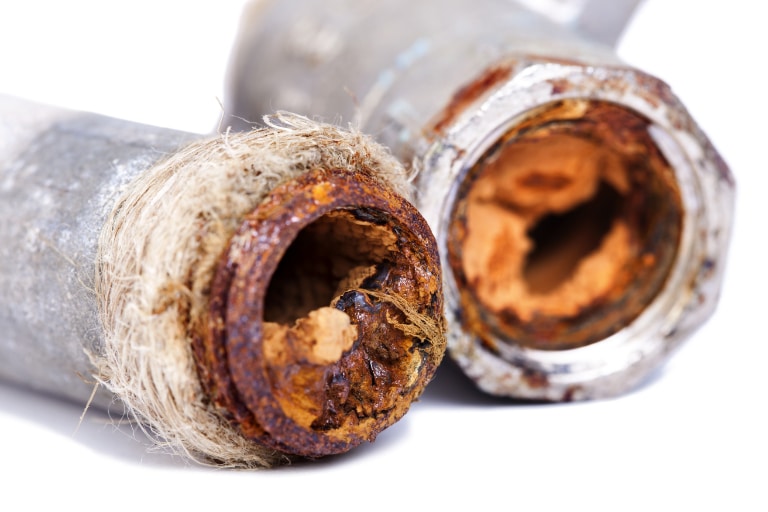Iron In Your Well Water?
Elevated levels of Iron (rust) are often a water quality issue for well owners. Iron makes up 5% of the Earth’s crust and it’s no surprise that elemental iron quickly dissolves and seeps into groundwater, making it a growing problem for well owners. As Iron passes through rocks and minerals, it forms aquifers. The longer the groundwater flows through the cracks and crevices underground, the more the iron concentration increases and causes the creation of iron bacteria.
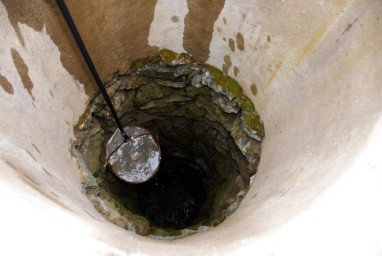
Excess iron and iron bacteria in wells and household water create several serious issues. Eliminating or controlling the amount of iron in your household water is extremely important for providing pure, clean drinking water and extending the life of your household plumbing and appliances.
Is Iron Harmful?
Iron is a necessary human nutrient. The EPA (Environmental Protection Agency) has set the Maximum Contaminant Level at 0.3 milligrams per liter (0.3 mg/l) as a guide for drinking water, stating it is not a primary health concern. However, the EPA listed iron as a secondary contaminant in drinking water, meaning it may produce cosmetic and or aesthetic effects on the water. Excess iron bacteria levels will result in discoloration, staining, foul-smelling, unacceptable tasting drinking water, and possible irritation.

Naturally occurring iron bacteria are tiny living organisms found in soil, surface water, shallow groundwater, and wells. They form bacterial cells, rust deposits, and a thick slime as the bacteria combine with iron and oxygen. The thick rusty slime sticks the iron bacteria to pumps, plumbing fixtures, and well pipes, creating many undesirable and unwanted effects throughout your household.
Iron bacteria may affect the amount of water a well produces and can create an environment for the growth of other disease-producing organisms. Imagine getting a drink of your tap water only to find a cloudy rust-colored smelly glass of water. When doing laundry, you see all your clothes have become dull, yellowed, and your washing machine has rust staining. The dishwasher, sink, and dishes now have unsightly orange or brown stains in your kitchen, plus many other household issues.
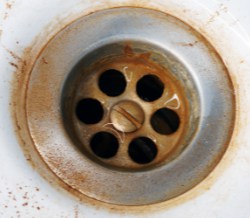
Elevated iron bacteria in your drinking water produces a wide range of adverse effects, including irritating hair and skin problems. Skin cells become damaged, causing faster drying and wrinkling of skin with heavy iron exposure. Build-up can produce dry hair and even hair odor. Extreme build-up can turn hair metallic orange or red. Heavy exposure also causes yellowing or discoloration of teeth over time.
Iron in well water that does not exceed the guidelines is considered safe but may still produce undesirable aesthetic problems. If left untreated, iron can quickly multiply with other contaminants such as sulfur, manganese, and other bacteria.
Iron bacteria can be detrimental and destructive to every household thing it comes in contact with, including dishes, silverware, clothing, tubs, showers, dishwashers, washing machines, pipes, faucets, and fixtures. It can produce a metallic taste in your coffee, tea, and cooked foods. Heavy doses of iron cause foul and rotting smelling water and make cloudy dark or black water, which may cause people to stop drinking the water, thinking it is unsafe.
Iron Bacteria and Hazardous Household Effects
There are four different types of iron found in wells and groundwater. The two common forms: ferric and ferrous iron, can be removed relatively easily with conventional water treatment methods. The third type is iron bacteria, and the fourth is known as heme iron, a heavier form of iron bacteria. Heme iron, also referred to as organic iron, is bound to organic compounds such as tannins or humic acids and can be clear, yellowish-brown, or pink.
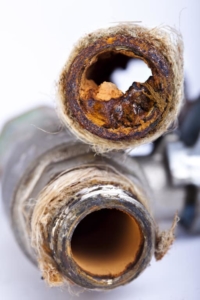
When iron bacteria and heme iron form, they produce a gelatinous bacterial sludge that thrives in an anaerobic or oxygen-deprived environment. This slime occurs as a natural defense against harmful water treatment chemicals, and it attaches to nutrient-rich areas such as pipes, steel casings, and other decaying bacteria, causing corrosion. Removal of both iron bacteria and heme iron requires a more advanced water treatment system that can be engineered to your specific well water conditions.
Over time, these increase rusty corrosive bacteria build-up, clogging or blocking household plumbing, water treatment systems, and appliances. The thick sludge clogs or plugs pipes, solenoids, nozzles, faucet aerators, and much more. The results will lead to increased maintenance issues or even complete malfunction of these systems causing a heavy financial burden. Eliminating this corrosive build-up is essential to ensure your plumbing and appliances function properly and last longer. These issues highlight the importance of ensuring the purchase of a scientifically-proven high-quality professional home iron removal solution.
How High Is the Iron Level in Your Water?
The first step is to perform a professional lab water quality analysis which will provide a snapshot of your current well water condition. It will show the amount and type of iron and other vital levels such as sulfur, manganese, and chlorine. The water test results will help determine the best and most effective water treatment system for your household water supply. Keep in mind that wells new and old can experience water quality changes frequently. Therefore regularly testing well water is advised to keep your water quality at its cleanest, freshest, and purest, and this makes installing the right system for your needs essential.
Iron Removal Methods
Chlorination has been used as an effective water treatment solution in municipalities for many years. It is a highly effective and relatively inexpensive disinfecting solution. Chlorine effectively manages drinking water contaminant levels with its oxygenating effects. However, used in residential settings on its own, it is only marginally effective in removing heavy heme iron, odors, and iron bacteria. In recent years new methods have been developed and put into use to rid drinking water of these burdensome and detrimental bacterial contaminants.
High iron bacteria and heme iron concentrations in your well water will require an aggressive oxidation treatment with chlorine, ozone, or hydrogen peroxide. These methods start by converting dissolved iron into ferric or fully oxidized iron that a filter can trap. These systems involve using a chemical injection system, which injects the chemical into the water system and oxidizes the iron. Chlorine and ozone provide excellent water treatment and are highly effective at removing both ferric and ferrous iron but may not fully treat or remove the heavy accumulation of heme iron and iron bacteria.
The Hydrogen Peroxide Injection System
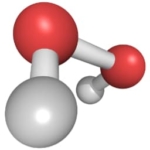
Using Hydrogen peroxide is one the best ways to rid your water of foul-smelling slimy iron and heme bacteria. Hydrogen Peroxide is an exceedingly powerful oxidant that produces disinfection of a wide range of organic chemicals. It is known as an advanced oxidation process, effective in destroying chemicals otherwise hard to treat. It can be used individually or in combination with other water treatment methods such as ultraviolet sterilization.
The hydrogen peroxide injection system provides two distinct benefits if your household water has odors or bacteria. First, it sterilizes the water by killing microbes and does not require the use of chemicals. Second, it is incredible at eliminating odors when combined with a whole-house carbon filter. The hydrogen peroxide injection system benefits well water with heavy bacterial contamination.
Well water from both new and older wells is prone to accumulating iron, sulfur, manganese, and iron bacteria. Hydrogen Peroxide rapidly attacks the iron and the bacteria, tannins, and foul odors without leaving a trace. Abbreviated as H202, it is a powerful oxidizer that works much faster than chlorine and decomposes, leaving behind no extra chemicals or by-products, only water, and oxygen. With its broader PH range, it can effectively treat more types of water. The residual oxygen also helps to prevent the growth of new bacteria.
A hydrogen peroxide injection system provides a simple, efficient, low maintenance, and highly effective iron removal solution. It is a reliable and powerful oxidizer that can work through almost any level of iron bacteria. Hydrogen peroxide does not leave any iron residue or sludge, nor does it plug the injector as some other chemicals can. It also rapidly eliminates other difficult contaminants such as sulfur and manganese.
These systems operate for many years requiring very little maintenance, only to add the peroxide as needed. One essential advantage is, Hydrogen Peroxide injection systems can be individually engineered for your specific well water system and filter needs based on your water analysis.
How Does A Hydrogen Peroxide Injection System Work?
Hydrogen peroxide is safe, easy to use, and controlled when handled appropriately. The peroxide does its job swiftly, efficiently, and entirely, and where chlorine needs a lengthy exposure, peroxide only needs seconds.
A proportional injection system injects hydrogen peroxide via a chemical feed pump into the feed water. Next, the water flows through the iron, sulphur & manganese filter and then the carbon filter and media bed, removing all oxidized contaminants, including iron bacteria and any residual hydrogen peroxide. The proportional hydrogen peroxide injection system is the preferred method; it is quick, efficient, and does not require excess contact time or pressure.
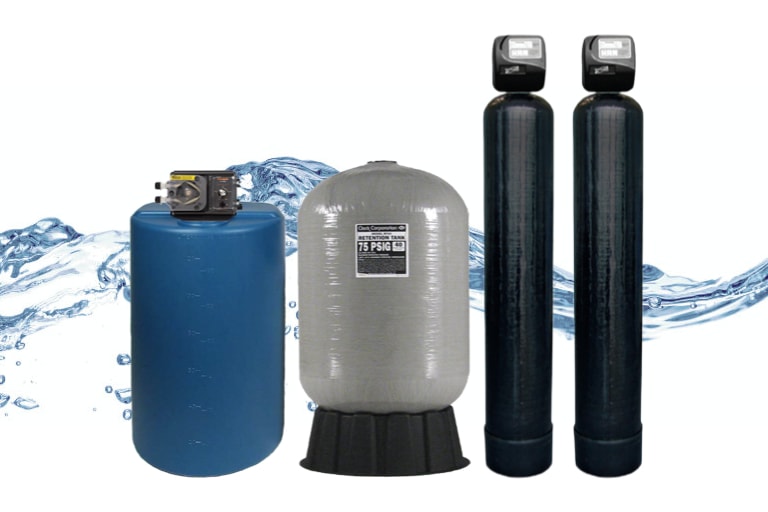
The carbon filter is made from coconut shells, which are an excellent source of activated carbon and have a high volume of micropores, making them perfect for filtration. Coconut carbon-based filters are a renewable resource and are environmentally friendly. They not only provide fine sediment and contaminant filtration but are also excellent at filtering out unwanted chlorine by-products or THMs (Trihalomethanes).
Treatment with hydrogen peroxide injection protects your plumbing and household appliances from further damage. The hydrogen peroxide is powerful enough to eradicate any iron and sulfur bacteria as well as other sediment and pathogens. Any rotten or foul odors are also neutralized in the process.
The initial cost of a hydrogen peroxide injection system may be slightly higher than other solutions, but they operate for many years and require very little maintenance. The only ongoing cost is the annual purchase of hydrogen peroxide. The hydrogen peroxide must be refilled when levels in the retention tank become low.
Benefits of A Hydrogen Peroxide Injection System
Many industrial facilities are switching to hydrogen peroxide for their complex water treatment. Some of the main benefits of using Hydrogen peroxide for water treatment include:
- Works faster than Chlorine
- Cleans any organic deposits from the irrigation systems
- Kills bacteria and prevents & eliminates bacterial slime.
- Hydrogen peroxide is biodegradable
- Hydrogen peroxide decomposes in water, leaving no chemical residue
- Removes hydrogen sulfide gas and any odors it causes
- Even with high organic loads, it improves main and secondary filtration
- Does not pollute water and is environmentally friendly
- Produces more oxygen which benefits soil and plants
Hydrogen peroxide is unique in its advantages; it is a powerful oxidizer, and is a quick and efficient disinfectant. When handled properly, it is safe to work with and does not form or leave toxic by-products; any remaining oxygen helps prevent the further development of any anaerobic (unoxidized) bacteria.
Problem-causing iron bacteria and heme iron must be removed in order to have pure, fresh, and clear water for drinking and your household. If you are concerned about the unwanted and harmful effects of iron bacteria in your water, consider a Hydrogen Peroxide Injection Water Treatment System from Excalibur Water Systems to provide worry-free, safe, pure water for your home and family.
For more information about the Excalibur Water Systems Hydrogen Peroxide Injection System, please contact us.